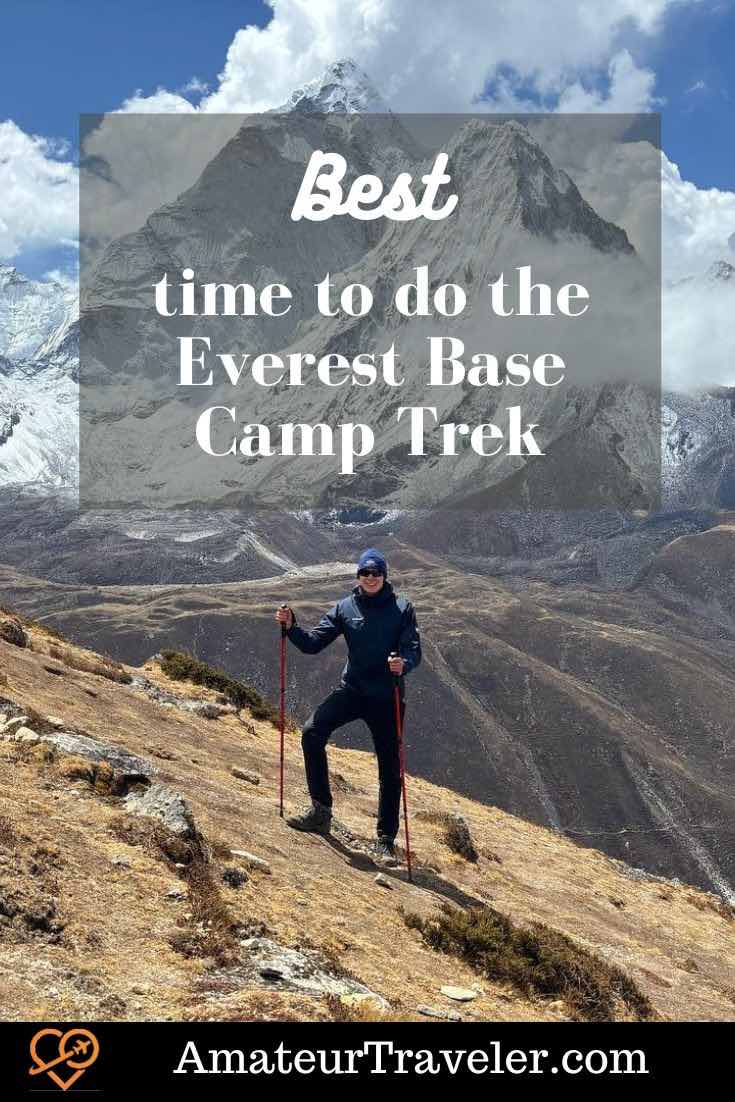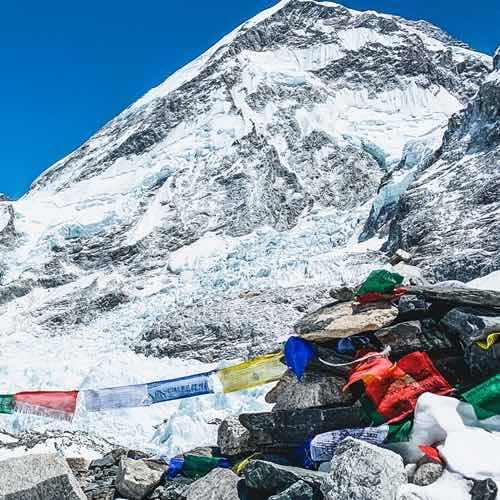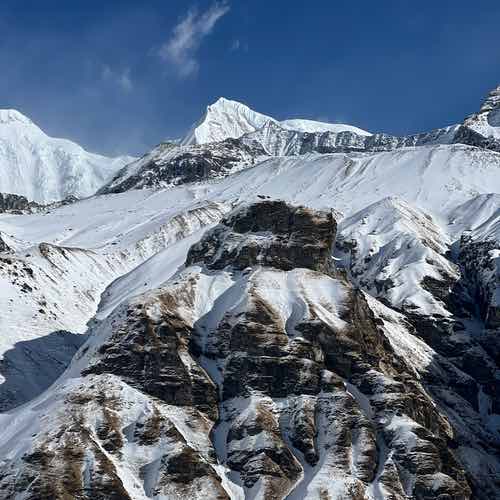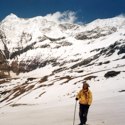Kusum Kangru (6,367 m)
Many adventurers and travelers dream of trekking to Everest Base Camp, the foot of the world’s tallest mountain, Mt. Everest. This truly unique destination will leave you gasping at every turn. Choosing the right time to travel is crucial, as it will impact your trip experience, especially when the trip takes you amidst some of the highest mountains on earth.
You must be wondering, what is the best time to do the Everest Base Camp Trek?
Even though many suggest a specific season for the trek, namely spring and autumn, interestingly enough, the trail to the Everest Base Camp is trekked throughout the year. But the season you travel in does make a difference in your experience. Nepal generally operates in four seasons: summer, spring, autumn, and winter, but you can also add monsoon to the mix during the summer. However, each season has its upsides as well as some downsides. This article will explain what it is like to trek to the Everest Base Camp in different seasons.
View of Lhotse (8,516 m), Nuptse (7,861 m), and Everest (8848.86 m) on the way to Dingboche
Spring Season (March-May)
Spring is unquestionably the best season for trekking to Everest Base Camp or any other trekking destination in Nepal. From March to May, it is peak trekking season. One major reason is that the season offers relatively stable weather, moderate temperatures, and a crisp, clear sky that allows you to get the best view of the mountain landscapes.
Weather and Temperature
The weather in spring is clear, and the temperature is mostly moderate but can be cold as you go higher. Lower elevations, such as Lukla to Namche Bazaar, have a mild temperature during the day and chilly during the night. Higher elevations, from Dingboche to Base Camp, are cold throughout the year. The average daytime temperature at lower elevations is 10°C to 15°C (50°F to 59°F) and 0°C to 5°C (32°F to 41°F) during the night.
Look forward to
One of the best parts about trekking in the spring is the clear weather and sky. Spring brings lush green alpine forests with blossoming flowers, especially the rhododendron, Nepal’s national flower. The sunny trail with bright blue sky offers the best background for the mountains, such as Ama Dablam, Mt. Everest, Lhotse, etc., to shine.
It is the season for treks, and it is also the season for expeditions to summit Everest. You will see tents lined up in the base camp and climbers preparing or training for the expedition.
Look out for
Spring is the peak season for trekking in Nepal, especially in a popular destination like Everest Base Camp. There are bound to be a lot of trekkers on the trail, and it can be particularly crowded as there will also be many groups who are there for the Everest expedition. While it won’t pose many problems except the feeling of overcrowding at times, it makes up for it by having the best weather for trekking.
View of Kongde Peak (6,187 m)
Summer Season (June–August)
Trekking during the summer can be a bit tricky but not entirely impossible. As it is not only summer but also monsoon season in Nepal, which means there will be the maximum chance of rain, especially during July and August. However, one thing that is guaranteed is greenery. Especially when the sky clears after the rain, the views you will see are a blessing to the eyes.
Weather and Temperature
With the monsoon season at its peak, it is the wettest season because there will be frequent rain in all parts of the country. It is also summer, so it will not be as cold as other seasons. But then again, mountain regions are always cold. However, the temperature of the lower regions is warmer, with 15°C to 20°C (59°F to 68°F) during the day and 5°C to 10°C (41°F to 50°F) at night. Meanwhile, at higher altitudes, the temperatures range from 0°C to 5°C (32°F to 41°F) and -3°C to 0°C (27°F to 32°F) at day and night, respectively.
Look forward to
One of the main highlights of trekking during the summer is the lush greenery. Even though the rain can be a bit of an obstacle, the scenery is staggeringly beautiful: green Alpine forests and green grazing grassland. The clean and clear view of the mountains once the rain subsides is truly phenomenal. Another great thing is that there will be fewer crowds than in spring or autumn. This means you can trek to the base camp with fewer disturbances.
Look out for
What you have to be prepared for from day one about trekking during the summer/monsoon is the rain. While the views and less crowded trail seem enticing, there is a high chance you will walk in the rain for most days of your trek. The trail will be slippery, and different areas are prone to landslides, so you have to be extra careful and have a high chance of attracting leeches. So, if you are someone who does not enjoy monsoon treks or just walking in the rain in general, this season probably isn’t for you.
View of Lhotse (8,516 m) and Everest (8848.86 m)
Autumn Season (September–November)
Autumn, otherwise known as the fall, is another season regarded as the best time to trek to the Himalayas, especially the Everest Base Camp. Truly a wonderful time to trek, as you will be rewarded with beautiful views of the mighty mountains underneath a clear blue sky.
Weather and Temperature
Speaking about the weather and temperature, the fall season offers more stable days with less rainfall and a sky without a cloud in sight. This is why many trekkers often prefer autumn over other seasons. It is slightly colder compared to the spring season, but definitely manageable. The temperature at lower elevations ranges from 8°C to 12°C (46°F to 53°F) during the day and -2°C to 5°C (28°F to 41°F) at night. At higher altitudes, the day and night temperatures are -8°C to 2°C (17°F to 35°F) and -12°C to -5°C (10°F to 23°F), respectively. You will find that the days are warmer in the lower region, but nights get colder, especially the higher you go. Therefore, it is essential to pack accordingly to combat the cold of the mountains.
Look forward to
The best thing about trekking in autumn is the unmatched views. Not only will it be sunny with a bright blue sky, but the sun won’t be as harsh as during the spring or summer. Catching glimpses of mighty mountains like Mt. Everest, Ama Dablam, and so on will be tearjerkers. Another big perk of trekking during October and November is that you might experience the biggest festival for the Sherpas of Everest, the Mani Rimdu Festival. The festival falls on the ninth month of the Tibetan lunar calendar every year, which falls during October or November. It will have a different ambiance as you get the best views of the landscape, the best weather, and a chance to participate in the festivities. It truly is an ideal time for those who wish to immerse in nature and culture at the same time.
Look out for
Similar to spring, autumn also attracts a large number of trekkers from all over the globe. It is also the time for the fall expedition, so the number of people trekking the EBC trail increases. The trail and teahouses can be crowded, which can be a bit too much at times. And the higher you go, the colder it gets.
View of Khumbutse (6,636 m) and Nuptse (7,861 m) from Lobuche
Winter Season (December–February)
Being the coldest time of the year, it can be quite difficult to do this trek, but with the right gear, equipment, and preparation, you can turn the whole thing around and have the best time. Winter means cold and snow but also offers the clearest sky and the best view of the snow-covered landscapes and snow-capped mountains.
Weather and Temperature
The cold place gets even colder during the winter. And the Everest region sees snowfall that coats the entire region with pristine white snow. Walking through the ice and snow, you will be able to feel the chills of the cold of the Khumbu. The temperature during the day is about 5°C to 10°C (41°F to 50°F) in the lower region and -5°C to 0°C (23°F to 32°F) during the night. There will be a significant drop in temperature at the higher elevations with -12°C to -5°C (10°F to 23°F) during the day and -20°C to -15°C (-4°F to 5°F) during the night. This only shows how prepared you must be if you plan to trek during the winter.
Look forward to
The winter season might have a reputation for being extremely cold, but it is one of the best times to trek to Everest. With the right preparation, you will have the best experience. You will not get to see or walk on snow during the other season, but in winter, you can play with snow to your heart’s content. The higher elevations are covered in snow, which makes for a tranquil landscape. The cold brings clear skies, meaning unobstructed views of the towering mountains surrounding you. Trekking in winter also means fewer crowds. Especially if you are on a solo trek and want to just be by yourself, this is the perfect time. There will be no one in front of you or behind you. It will just be you and occasional other fellow trekkers who are also looking to enjoy some self-time among the trails of the mountains.
Look out for
As has already been emphasized, it will be extremely cold, especially at higher altitudes. So, if you do not cope very well with cold and dislike snow, the winter trek is not for you. You will be walking on ice and snow and require gear such as crampons because the paths are slippery and full of risks. There are only limited tea houses open, so the services might not live up to the expectations. You also need to carry your own sleeping bag, as the teahouse sometimes does not have sufficient blankets. Another downside is that because the days are shorter in winter, you will have less daylight and will have to retire for the day earlier.
View of Ama Dablam (6,812 m)
Preparing for different weather conditions
No matter the time of the year, the Everest Base Camp Trek will always be cold. The only thing is that winter is much colder than the other seasons. So, you have to prepare and pack accordingly. First, you need to understand the concept of layering during the trek. You will need to carry extra sets of clothes during the winter, but by layering your clothes from the base, middle, and outer layers, you will be warm even in the harsh, cold winter. You will need clothes that are specifically designed for outdoor activities and will be able to withstand wind, rain, and snow.
Conclusion
Spring and autumn are the best times to trek, and rightfully so, as the two seasons have the best environment to trek in, with moderate temperatures and clear weather. However, it can be a bit overcrowded at times. So, if you are someone who enjoys peace with fewer people, then these two seasons are not for you. Summer and winter have fewer crowds, but each has their downside. The summer season experiences high rainfall, which can be very risky to travel as many areas of Nepal are prone to landslides. The trails will also be muddy and slippery, but the greenery you see during this time, you won’t get to witness in other seasons. Winter is another season where you can enjoy the peace while hiking. But it is one of the best seasons to get the most undisturbed view of the snow-covered landscape.
Choosing when to do the trek can be quite hard. But with the information provided above, you now have a better understanding to make your plan for the Everest Base Camp Trek in the future. Mt. Everest will always welcome you, no matter which season you choose to visit. Just remember to prepare and pack accordingly to have a smooth trekking experience when you see the world’s tallest peak for the first time.
Leave a Reply
Tags: article, mount everest, nepal


 Everest Base Camp Trek: A Journey to the Roof of the World in Nepal
Everest Base Camp Trek: A Journey to the Roof of the World in Nepal Helicopter Tour to Everest Base Camp: A Visual Guide
Helicopter Tour to Everest Base Camp: A Visual Guide My Journey to Annapurna Base Camp
My Journey to Annapurna Base Camp Roopkund Trek: My Himalayan Death Trek – India
Roopkund Trek: My Himalayan Death Trek – India
